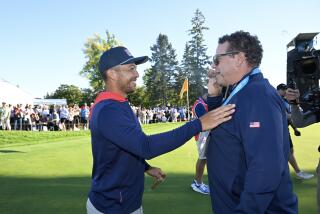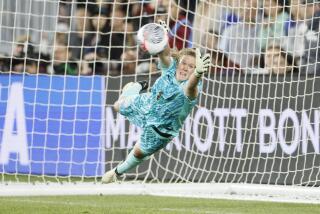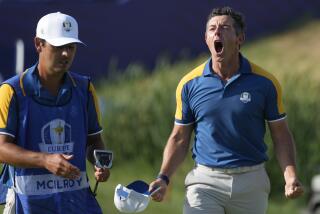Americans Attempt to Regain Cup
- Share via
A tale of the tape points to an early knockout in the Ryder Cup.
Five Americans have won major championships, the best measure of poise under pressure. Europe doesn’t have a major champion on its team for the first time in the last 10 matches.
The Americans have seven players among the top 15 in the world. Europe has two.
U.S. captain Hal Sutton snatched a sheet of paper from the table and scanned down the list of world rankings, indisputable evidence that his team is deep, talented and should be favored again to win the Ryder Cup, just like it is every other year these two continents get together.
One problem.
Europe has captured the cup six of the last nine times, and its dominance would be even greater if not for Justin Leonard making a 45-foot birdie putt to cap off an improbable comeback at Brookline five years ago.
Anyone who thinks the Americans should be favored hasn’t been paying attention.
“Everybody always speculates as to why the Europeans fight above their weight, and why the Americans look like heavyweights and fight like featherweights,” Sutton said.
“They add up the world ranking, and when you look at the U.S. versus Europe, it’s pretty lopsided,” he said. “But one great thing about the game of golf is that David beats Goliath sometimes.”
Anymore, it’s hard to figure out who is who.
“Are we the underdogs?” Phil Mickelson said. “That’s a good question. They bring out their best game in the event, and we have not in years past.”
The Americans will try to change that in the 35th Ryder Cup matches, which start Friday at Oakland Hills in the Detroit suburbs, the course Ben Hogan referred to as a “monster” when he won the 1951 U.S. Open.
The United States used to be a beast in this biennial affair, winning 13 consecutive times from 1959 to 1985 and still leading the series 24-8-2 since the matches began in 1927.
“They have always been the favorites,” Sergio Garcia said. “But it’s all about coming together and playing good golf. And we’ve been able to raise our bar for that week the last several years.”
Europe might not have to play over its head this time. While the U.S. again has strong credentials on paper, the teams look evenly matched for the first time since Europe’s “Fab Five” -- Nick Faldo, Seve Ballesteros, Ian Woosnam, Bernhard Langer and Sandy Lyle -- started to swing the tide in its favor two decades ago.
Both teams have five rookies. Both teams have only five players who have won this year. Both teams have a captain’s pick who won the week after he was selected -- Stewart Cink at the NEC Invitational, Luke Donald at the European Masters in Switzerland.
The one advantage for the Americans is playing at home, where it has lost the Ryder Cup just twice in the 77-year history of the matches -- in 1987 at Muirfield Village and in 1995 at Oak Hill.
Oakland Hills is no longer the monster it once was; 7,077 yards at a par 70 is not as daunting with today’s technology. The key has always been keeping the ball below the hole on the severely contoured greens.
“Our team has incredible putters,” Mickelson said.
Even so, Mickelson knows as well as anyone that nothing goes according to plan in a Ryder Cup.
Two years ago at The Belfry, the United States was in position to win the Ryder Cup by forging a tie at 8 going into the Sunday singles matches, which it usually dominates. But Mickelson was beaten by Phillip Price of Wales, the 119th-ranked player in the world, in a pivotal match that sent Europe to the most lopsided victory (15 1/2 -12 1/2 ) since 1985.
It was another example that while the United States brings stars to the Ryder Cup, Europe creates them.
Not many knew David Gilford of England until he won three points, including one of the four singles matches that went Europe’s way on the final hole at Oak Hill to win the cup.
Costantino Rocca knocked off two strong tandems -- Mickelson and Davis Love III, then Love and Fred Couples -- before whipping Tiger Woods in singles at Valderrama in 1997. And in the most recent victory, Paul McGinley rallied from 2 down to beat Jim Furyk, making an 8-foot par putt on the 18th hole to clinch the cup.
“Out of the shadows come heroes,” European captain Sam Torrance said that day.
How many more guys like that is Europe hiding in the dark?
And how much longer before fans realize that the United States is not necessarily the team to beat?
“We’re completely happy being the underdogs,” Lee Westwood said. “But if you look at the results week in and week out, we do as well as the Americans. As a European team, we expect to go to the Ryder Cup and win it. As a team, we tend to perform all the way through, and not just rely on any one individual.”
The one player always under the spotlight is Woods, and it usually causes him to sweat at the Ryder Cup. While he loves the competition and the camaraderie in the team room, Woods has never embraced the hoopla of the week, and his record bears that out.
He is 5-8-2 in the Ryder Cup, and he already has had eight partners in 12 team matches.
Sutton called out Woods not long after he was appointed captain, challenging him to live up to his reputation as the No. 1 player in the world. However, Woods is no longer the No. 1 player, replaced last week by Vijay Singh after five years at the top of the ranking.
Of greater concern is that Woods has only one victory this year, and that was seven months ago in the Match Play Championship. He has never gone this deep into a year with only one victory worldwide, and he no longer carries an intimidating presence.
Then again, maybe that’s what this U.S. team needs -- subtle reminders it is no longer the best.
Europe has reason to believe it can go home with the gold chalice. While it has no major champions for the first time since 1981, and Ryder Cup stalwart Colin Montgomerie had to rely on being a captain’s pick, several of its players have been in top form the last several months.
Miguel Angel Jimenez is a four-time winner in Europe. Thomas Levet looked sharp winning the Scottish Open and contended at the British Open. Donald has won twice in the last two months. Garcia, at 24 already playing in his third Ryder Cup, is a two-time winner on the PGA Tour.
“We have far more depth on the European team now than we ever had before,” said Langer, the European captain.
The matches have been extraordinarily close -- seven of the last nine Ryder Cups have been decided by two points or fewer.
*
(BEGIN TEXT OF INFOBOX)
Ryder Cup
The format for the 35th Ryder Cup matches, which starts Friday at Oakland Hills:
FOURSOMES
Alternate Shot
* Four matches Friday and Saturday with two players from each team. One player tees off on odd-numbered holes, the other tees off on even-number holes. They alternate shots until the hole is completed. Each match is worth one point.
FOURSOMES
Better Ball
* Four matches Friday and Saturday with two players from each team. Each man plays his own ball, and the team takes the lowest of the two scores on each hole. Each match is worth one point.
SINGLES
* Twelve matches Sunday with one player from each team. Each match is worth one point.
RESULTS
Last 10 Ryder Cups:
* 2002 -- Europe 15 1/2 , U.S. 12 1/2
* 1999 -- U.S. 14 1/2 , Europe 13 1/2
* 1997 -- Europe 14 1/2 , U.S. 13 1/2
* 1995 -- Europe 14 1/2 , U.S. 13 1/2
* 1993 -- U.S. 15, Europe 13
* 1991 -- U.S. 14 1/2 , Europe 13 1/2
* 1989 -- Europe 14, U.S. 14
* 1987 -- Europe 15, U.S. 13
* 1985 -- Europe 16 1/2 , U.S. 11 1/2
* 1983 -- U.S. 14 1/2 , Europe 13 1/2
Notable: Europe holds the Ryder Cup and needs only to tie -- 14 points apiece -- to retain the trophy. The United States needs 14 1/2 points to win.
More to Read
Go beyond the scoreboard
Get the latest on L.A.'s teams in the daily Sports Report newsletter.
You may occasionally receive promotional content from the Los Angeles Times.










